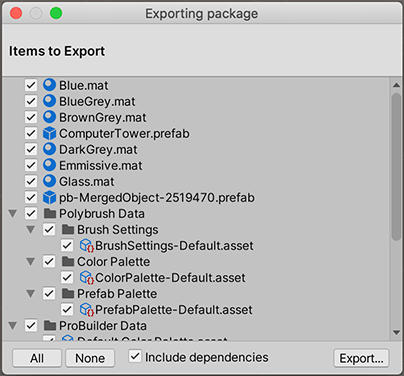创建您自己的资源包
注意:如果要共享场景、示例、工具或其他资源,Unity 建议创建您自己的资源包。但是,也可以使用资源包 (.unitypackage) 格式。例如,您可能想要创建一个资源包,将多个资源或整个场景从一个项目复制到另一个项目。
按本节中的说明,从 Unity 编辑器的 Assets 菜单中导出资源包。
注意:如果您的资源质量很高,并且您相信其他用户会认为它们很有用,请按照 发布到 Asset Store 文档中的说明创建资源包草案并将其上传到 Asset Store
要创建您自己的自定义资源包,请执行以下操作:
打开要从中导出资源的项目。
-
从菜单中选择 Assets > Export Package 以打开 Exporting package 对话框。

Exporting Package 对话框 在此对话框中,通过单击复选框来选择要包含在资源包中的资源。
将 Include dependencies 保持启用状态,即可自动选择已选资源使用的所有资源。
单击 Export 以打开文件资源管理器,然后选择要存储资源包文件的位置。
为资源包命名,并将其保存任何所需位置。
Tip: When exporting a package, Unity can export all dependencies as well. So, for example, if you select a Scene and export a package with all dependencies, then Unity exports all Models, Textures and other assets that appear in the Scene as well. This can be a quick way of exporting several assets without manually locating them all.
Note: If you select Include dependencies, and your current selection contains or references any scripts, Unity includes all scripts in your project. This is because Unity does not have a way to determine whether the scripts in your selection reference other scripts. For example, if you select a Scene asset in your project to export, and that scene contains a GameObject with a script attached, then Unity counts all scripts in your project as dependencies. If you do not want Unity to do this, you should uncheck Include dependencies.
重新导出资源包
如果要更改资源包的内容并创建资源包的更新版本,请在资源包中选择所需的资源文件(未更改的资源文件和新的资源文件)。然后,按照上述说明导出文件。
命名策略
请使用增量式名称来重命名更新的资源包:例如,MyAssetPackageVer1、MyAssetPackageVer2。Unity 会将其识别为更新,因此您应该使用对您和您与之共享的所有人而言都明确的命名约定。
警告:不要从资源包中删除文件,然后添加具有相同名称的不同文件。Unity 使用唯一的 ID 来跟踪文件,因此它会将它们识别为不同并可能相互冲突的文件。在这些情况下,Unity 在导入它们时会显示警告符号。如果已删除文件然后决定替换它,请将其重命名(即使它与原始名称很接近)。